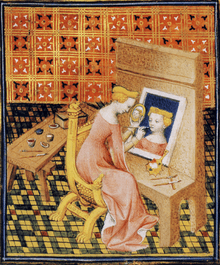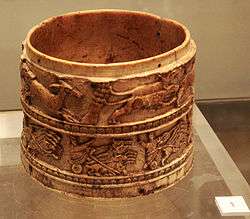Iaia

15th-century portrayal of Iaia from a French translation of De mulieribus claris.
Iaia of Cyzicus ("Marcia") was a Roman painter, alive during the time of Marcus Terentius Varro (116–27 BC).

Example of ancient Roman carved ivory, not attributed to Iaia
Born in Cyzicus,[1] she was a famous painter and ivory engraver. Most of her paintings are said to be of women. Among pictures ascribed to her was a large panel, in Naples, picture of an old woman and a self-portrait. She was said to have worked faster and painted better than her male competitors, Sopolis and Dionysius, which enabled her to earn more than them. Marcia remained unmarried all her life.
One of the six female artists of antiquity mentioned in Pliny the Elder's Natural History (XL.147–148) in A.D. 77: Timarete, Irene, Calypso, Aristarete, Iaia, Olympias.[2] They are mentioned later in Boccaccio's De mulieribus claris.
Notes
- ↑ Commire, Anne, ed. (2002). "Iaia (fl. c. 100 BCE)". Women in World History: A Biographical Encyclopedia. Waterford, Connecticut: Yorkin Publications. ISBN 0-7876-4074-3. (Subscription required (help)).
- ↑ J. Linderski. The Paintress Calypso and Other Painters in Pliny. Zeitschrift für Papyrologie und Epigraphik. Bd. 145 (2003), pp. 83-96
References
- Helen Gardner, Fred S. Kleiner, Christin J. Mamiya, Gardner's Art Through the Ages, Thomas Wadsworth, 2004; ISBN 0-15-508315-5.
- Pliny the Elder, Natural History, 35.40,147.L
- Virginia Brown's translation of Giovanni Boccaccio’s Famous Women, pp 135 – 137; Harvard University Press, 2001; ISBN 0-674-01130-9
- Harris, Anne Sutherland and Linda Nochlin, Women Artists: 1550-1950, Los Angeles County Museum of Art, Knopf, New York, 1976, pg. 23.
- Strife Guide
This article is issued from
Wikipedia.
The text is licensed under Creative Commons - Attribution - Sharealike.
Additional terms may apply for the media files.